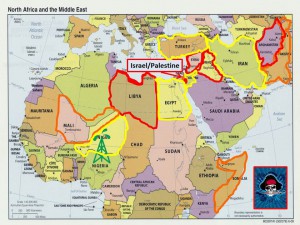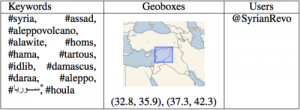
Citation: “Graphic: Updated US Swath of Destruction from Afghanistan to Niger,” Phi Beta Iota the Public Intelligence Blog, 31 May 2013.

Chinese business website Caixin Online has a great video on China’s Open Source Hardware Movement, this is an area that promises to change the manufacturing industry.
Open Source is the philosophy of sharing intellectual property and allowing anyone to improve the idea on the proviso they share their changes with the rest of the world.
The hope is that open sourced products end up being more reliable than proprietary designs due to scrutiny from hundreds, or thousands, of reviewers.
Until recently, open source has been largely restricted to the software world but now it’s moving into broader Engineering and manufacturing circles.
As the Caixin video shows, the open source hardware movement is introducing geeks to a tool which many thought was dead – the soldering iron.
I noticed this a week or so ago when I walked into a co-working space and found the lady I was meeting hunched over a soldering iron putting together a part for a quadcopter.
Right now soldering parts to build quadcopters or game controllers is just the beginning, the really interesting things start when open source meets 3D printing – then we’ll see some real game changing things happen.

Crowdsourcing Crisis Information from Syria: Twitter API vs Firehose
Over 400 million tweets are posted every day. But accessing 100% of these tweets (say for disaster response purposes) requires access to Twitter’s “Firehose”. The latter, however, can be prohibitively expensive and also requires serious infrastructure to manage. This explains why many (all?) of us in the Crisis Computing & Humanitarian Technology space use Twitter’s “Streaming API” instead. But how representative are tweets sampled through the API vis-a-vis overall activity on Twitter? This is important question is posed and answered in this new study, which used Syria as a case study.
The analysis focused on “Tweets collected in the region around Syria during the period from December 14, 2011 to January 10, 2012.” The first dataset was collected using Firehose access while the second was sampled from the API. The tag clouds above (click to enlarge) displays the most frequent top terms found in each dataset. The hashtags and geoboxes used for the data collection are listed in the table below.

. . . . .
In terms of social network analysis, the the authors were able to show that “50% to 60% of the top 100 key-players [can be identified] when creating the networks based on one day of Streaming API data.” Aggregating more days’ worth of data “can increase the accuracy substantially. For network level measures, first in-depth analysis revealed interesting correlation between network centralization indexes and the proportion of data covered by the Streaming API.”
Read full post with graphs and other links.
Continue reading “Patrick Meier: Crowdsourcing Syrian Crisis via Twitter API”

Collaboration depends on communication, and content depends on combination of social negotiation and creative energy.
Stigmergic Collaboration: The Evolution of Group Work
M/C Journal, May 2006
Introduction
1The steady rise of Wikipedia.org and the Open Source software movement has been one of the big surprises of the 21st century, threatening stalwarts such as Microsoft and Britannica, while simultaneously offering insights into the emergence of large-scale peer production and the growth of gift economies.
2Many questions arise when confronted with the streamlined efficacy and apparent lack of organisation and motivation of these new global enterprises, not least “how does this work?” Stigmergic collaboration provides a hypothesis as to how the collaborative process could jump from being untenable with numbers above 25 people, towards becoming a new driver in global society with numbers well over 25,000.
Complete post with references below the line.
Continue reading “Jean Lievens: Stigmergic Collaboration: The Evolution of Group Work”
 Kurator is a web service which allows you to easily customize one or more visual magazines that automatically aggregate the hashtags, lists, Twitter users, Facebook pages and RSS feeds you specify.
Kurator is a web service which allows you to easily customize one or more visual magazines that automatically aggregate the hashtags, lists, Twitter users, Facebook pages and RSS feeds you specify.
Specifically, you can aggregate from the following sources:
You can also filter and specify specific keywords that you want to be included/excluded.
Kurators offers the ability to title each stream, and to customize somewhat the look of the final magazine by providing a few templates and layouts and access to the controls to adjust the font style, size and color.
The final stream can be published as a web page on Kurator or exported directly to WordPress as a “page”.
Continue reading “Robin Good: Automated Topic-Specific Online Curation Tool”

Results: Analyzing 2 Million Disaster Tweets from Oklahoma Tornado
Thanks to the excellent work carried out by my colleagues Hemant Purohit and Professor Amit Sheth, we were able to collect 2.7 million tweets posted in the aftermath of the Category 4 Tornado that devastated Moore, Oklahoma. Hemant, who recently spent half-a-year with us at QCRI, kindly took the lead on carrying out some preliminary analysis of the disaster data. He sampled 2.1 million tweets posted during the first 48 hours for the analysis below. Read full post.
How Online Gamers Can Support Disaster Response
FACT: Over half-a-million pictures were shared on Instagram and more than 20 million tweets posted during Hurricane Sandy. The year before, over 100,000 tweets per minute were posted following the Japan Earthquake and Tsunami. Disaster-affected communities are now more likely than ever to be on social media, which dramatically multiplies the amount of user-generated crisis information posted during disasters. Welcome to Big Data—Big Crisis Data.
Humanitarian organizations and emergency management responders are completely unprepared to deal with this volume and velocity of crisis information. Why is this a problem? Because social media can save lives. Recent empirical studies have shown that an important percentage of social media reports include valuable, informative & actionable content for disaster response. Looking for those reports, however, is like searching for needles in a haystack. Finding the most urgent tweets in an information stack of over 20 million tweets (in real time) is indeed a major challenge. Read full post.